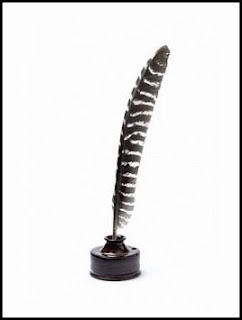 Have you ever wondered what is meant by dates of the form 24 February 1616/1617 (where the year is written as two numbers, separated by a slash)? At one time, I thought they probably represent uncertain dates, and wondered why so many researchers were content with inexact years in so many dates..
Have you ever wondered what is meant by dates of the form 24 February 1616/1617 (where the year is written as two numbers, separated by a slash)? At one time, I thought they probably represent uncertain dates, and wondered why so many researchers were content with inexact years in so many dates..I now realize that the date 24 February 1616/1617 represents a single, known date--the two years and a slash are required to unambiguously represent a specific day. This posting today attempts to explain what it all means.
New Year's Day in Colonial America
For most of us (using western calendars today) the new year begins on January 1. That is because the Gregorian calendar (the one commonly used in the world today, named after Pope Gregory) works that way: Every January 1 is the beginning of a new year.
During most of America's colonial period, however, March 25 was the first day of the new year. In 1750, for example, the year ended on 24 March 1750; the following day was 25 March 1751. In that time period, New Englanders were still considered part of Great Britain, which continued to use the "old" Julian Calendar (named after Julius Caesar) until September 1752.
The Transition from the Julian to the Gregorian Calendar
Prior to the reign of Julius Caesar (Emperor of Rome), the calendar had no leap years. Without leap year adjustments, the calendar used in Rome before Julius would drift completely around every 1,461 years. In an attempt to check the drift, Julius added a leap year every four years, beginning in the year 46 B.C. In order to implement his transition, the year 46 B.C. had 445 days, and was referred to by Romans as the "year of confusion."
With leap years every four years, the annual drift of the calendar was far less serious. However, by the sixteenth century (the 1500s), it had become obvious to scientists that adding an extra day every year overcompensated for the drift. To fine-tune the drift, it was determined that years that are multiples of 100 (the years 1700, 1800 and 1900, for example), should have no extra leap day--unless the year is also a multiple of 400 (such as 1600 or 2000), which would still have the leap day (!!).

In 1582, Scientists finally convinced Pope Gregory that it was time to adjust the calendar. In Italy, Spain, Portugal, and Catholic parts of Switzerland, 4 October 1582 was followed by 15 October 1582--the ten days from 5 October to14 October were skipped in those areas.
 In England, Henry VIII had broken with Rome only about fifty years earlier (creating the Church of England), so the English weren't inclined to follow the Pope's lead in the transition to the Gregorian calendar. By the mid-18th century, however, it became apparent that England (and her colonies) could avoid the transition no longer. A calendar reform bill of 1751 entitled "An Act for regulating the commencement of the Year, and for correcting the Calendar now in use" set the stage for the transition: 2 September 1752 was to be followed by 14 September 1752. Additionally, 31 December 1752 would be followed by 1 January 1753 (rather than 1 January 1752).
In England, Henry VIII had broken with Rome only about fifty years earlier (creating the Church of England), so the English weren't inclined to follow the Pope's lead in the transition to the Gregorian calendar. By the mid-18th century, however, it became apparent that England (and her colonies) could avoid the transition no longer. A calendar reform bill of 1751 entitled "An Act for regulating the commencement of the Year, and for correcting the Calendar now in use" set the stage for the transition: 2 September 1752 was to be followed by 14 September 1752. Additionally, 31 December 1752 would be followed by 1 January 1753 (rather than 1 January 1752).The command "cal 9 1752", issued on my FreeBSD computer, gives the following output, which shows what September 1752's calendar looked like:
September 1752
Su Mo Tu We Th Fr Sa
1 2 14 15 16
17 18 19 20 21 22 23
24 25 26 27 28 29 30
Dates that appear in Colonial vital records before 2 September 1752 are Julian dates. In any given year, the dates from 1 January through 24 March are candidates for "slashed" years. The year before the slash is the year actually recorded (generally) in documents of the period. The year after the slash is one year later--for the benefit of minds that think that the new year begins on 1 January (?).
NOTE: You shouldn't ever find slashed dates in the range 25 March through 31 December. (If you do find them, then they probably indicate uncertainty of some sort--they are not the slashed dates discussed here.)
What Date Is It Really?
The dates recorded in original birth, marriage, death and other vital records in New England prior to September 1752 are Julian dates--in accordance with the calendars used during that time period. When you copy the dates into your records, you should enter the dates as they were recorded originally. If the dates lie between 1 January and 24 March (inclusive), you should enter the year as recorded, followed by a slash and the subsequent year.




